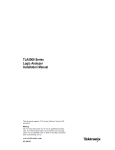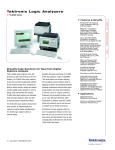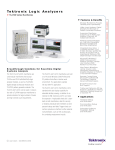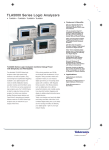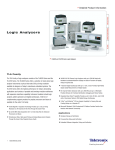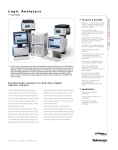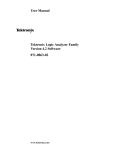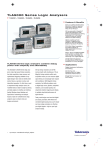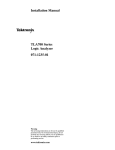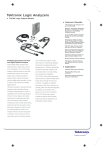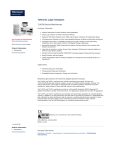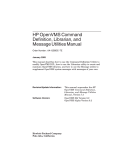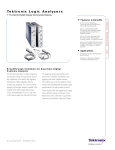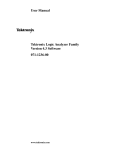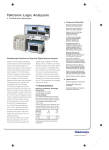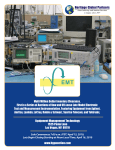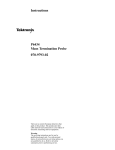Download P6419 Logic Analyzer Probe Instructions
Transcript
Instructions P6419 Logic Analyzer Probe 071-1303-00 www.tektronix.com *P071130300* 071130300 Copyright © Tektronix, Inc. All rights reserved. Licensed software products are owned by Tektronix or its suppliers and are protected by United States copyright laws and international treaty provisions. Use, duplication, or disclosure by the Government is subject to restrictions as set forth in subparagraph (c)(1)(ii) of the Rights in Technical Data and Computer Software clause at DFARS 252.227-7013, or subparagraphs (c)(1) and (2) of the Commercial Computer Software - Restricted Rights clause at FAR 52.227-19, as applicable. Tektronix products are covered by U.S. and foreign patents, issued and pending. Information in this publication supercedes that in all previously published material. Specifications and price change privileges reserved. Tektronix, Inc., 14200 SW Karl Braun Drive, Beaverton, OR 97077 TEKTRONIX, TEK, TLAVu, PatGenVu, and MagniVu are registered trademarks of Tektronix, Inc. HARDWARE WARRANTY Tektronix warrants that the products that it manufactures and sells will be free from defects in materials and workmanship for a period of one (1) year from the date of shipment. If a product proves defective during this warranty period, Tektronix, at its option, either will repair the defective product without charge for parts and labor, or will provide a replacement in exchange for the defective product. In order to obtain service under this warranty, Customer must notify Tektronix of the defect before the expiration of the warranty period and make suitable arrangements for the performance of service. Customer shall be responsible for packaging and shipping the defective product to the service center designated by Tektronix, with shipping charges prepaid. Tektronix shall pay for the return of the product to Customer if the shipment is to a location within the country in which the Tektronix service center is located. Customer shall be responsible for paying all shipping charges, duties, taxes, and any other charges for products returned to any other locations. This warranty shall not apply to any defect, failure or damage caused by improper use or improper or inadequate maintenance and care. Tektronix shall not be obligated to furnish service under this warranty a) to repair damage resulting from attempts by personnel other than Tektronix representatives to install, repair or service the product; b) to repair damage resulting from improper use or connection to incompatible equipment; c) to repair any damage or malfunction caused by the use of non-Tektronix supplies; or d) to service a product that has been modified or integrated with other products when the effect of such modification or integration increases the time or difficulty of servicing the product. THIS WARRANTY IS GIVEN BY TEKTRONIX IN LIEU OF ANY OTHER WARRANTIES, EXPRESS OR IMPLIED. TEKTRONIX AND ITS VENDORS DISCLAIM ANY IMPLIED WARRANTIES OF MERCHANTABILITY OR FITNESS FOR A PARTICULAR PURPOSE. TEKTRONIX’ RESPONSIBILITY TO REPAIR OR REPLACE DEFECTIVE PRODUCTS IS THE SOLE AND EXCLUSIVE REMEDY PROVIDED TO THE CUSTOMER FOR BREACH OF THIS WARRANTY. TEKTRONIX AND ITS VENDORS WILL NOT BE LIABLE FOR ANY INDIRECT, SPECIAL, INCIDENTAL, OR CONSEQUENTIAL DAMAGES IRRESPECTIVE OF WHETHER TEKTRONIX OR THE VENDOR HAS ADVANCE NOTICE OF THE POSSIBILITY OF SUCH DAMAGES. Table of Contents General Safety Summary . . . . . . . . . . . . . . . . . . . . . . . . . . . . . . . . . . . Preface . . . . . . . . . . . . . . . . . . . . . . . . . . . . . . . . . . . . . . . . . . . . . . . . . . . v vii Related Documentation . . . . . . . . . . . . . . . . . . . . . . . . . . . . . . . . . . . . . . . . . . . Contacting Tektronix . . . . . . . . . . . . . . . . . . . . . . . . . . . . . . . . . . . . . . . . . . . . . vii viii Product Description . . . . . . . . . . . . . . . . . . . . . . . . . . . . . . . . . . . . . . . . 1 Mictor-on-PCB to Compression Adapter . . . . . . . . . . . . . . . . . . . . . . . . . . . . . . Compression-on-PCB to P6434 Mictor Adapter . . . . . . . . . . . . . . . . . . . . . . . . 2 3 Attaching Probe Labels . . . . . . . . . . . . . . . . . . . . . . . . . . . . . . . . . . . . . Connecting the Probes to the Logic Analyzer . . . . . . . . . . . . . . . . . . . Cleaning the P6419 Compression Footprints . . . . . . . . . . . . . . . . . . . Cleaning the P6419 Probe Heads . . . . . . . . . . . . . . . . . . . . . . . . . . . . . Storing the P6419 Probe Heads . . . . . . . . . . . . . . . . . . . . . . . . . . . . . . Connecting the Probes to the Target System . . . . . . . . . . . . . . . . . . . . 5 7 8 8 9 10 Connecting the P6419 High Density Probes . . . . . . . . . . . . . . . . . . . . . . . . . . . Connecting the Mictor-on-PCB to Compression Adapter . . . . . . . . . . . . . . . . . Connecting the Compression-on-PCB to P6434 Mictor Adapter . . . . . . . . . . . 10 13 13 Designing an Interface Between the P6419 Probe and a Target System . . . . . . . . . . . . . . . . . . . . . . . . . . . . . . . . . . . . . . . . . . . . . . . . 15 Operating Basics Reference Signal Fixturing Considerations . . . . . . . . . . . . . . . . . . . . . . . . . . . . . . . . . . . . . Signal Names . . . . . . . . . . . . . . . . . . . . . . . . . . . . . . . . . . . . . . . . . . . . . . . . . . . Land Footprints . . . . . . . . . . . . . . . . . . . . . . . . . . . . . . . . . . . . . . . . . . . . . . . . . . Mechanical Considerations . . . . . . . . . . . . . . . . . . . . . . . . . . . . . . . . . . . . . . . . Special Considerations . . . . . . . . . . . . . . . . . . . . . . . . . . . . . . . . . . . . . . . . . . . . Physical Attachment Requirements for P6419 probes . . . . . . . . . . . . . . . . . . . . Physical Attachment Requirements for the Compression-on-PCB to P6434 Mictor and Mictor-on-PCB to Compression Adapters . . . . . . . . . . . . . . . . Electrical Considerations . . . . . . . . . . . . . . . . . . . . . . . . . . . . . . . . . . . . . . . . . . Transmission Lines . . . . . . . . . . . . . . . . . . . . . . . . . . . . . . . . . . . . . . . . . . . . . . . P6419 High-Density Probe Load Model . . . . . . . . . . . . . . . . . . . . . . . . . . . . . . 15 19 27 30 33 33 Specifications . . . . . . . . . . . . . . . . . . . . . . . . . . . . . . . . . . . . . . . . . . . . . 38 Probe Calibration . . . . . . . . . . . . . . . . . . . . . . . . . . . . . . . . . . . . . . . . . Functional Check . . . . . . . . . . . . . . . . . . . . . . . . . . . . . . . . . . . . . . . . . . Inspection and Cleaning . . . . . . . . . . . . . . . . . . . . . . . . . . . . . . . . . . . . P6419 Probe Service Procedures . . . . . . . . . . . . . . . . . . . . . . . . . . . . . Repackaging Instructions . . . . . . . . . . . . . . . . . . . . . . . . . . . . . . . . . . . 41 41 41 42 42 35 35 35 36 Maintenance P6419 Logic Analyzer Probe Instructions i Table of Contents Replaceable Parts Parts Ordering Information . . . . . . . . . . . . . . . . . . . . . . . . . . . . . . . . . Using the Replaceable Parts List . . . . . . . . . . . . . . . . . . . . . . . . . . . . . 43 43 Index ii P6419 Logic Analyzer Probe Instructions Table of Contents List of Figures Figure 1: P6419 logic analyzer probe . . . . . . . . . . . . . . . . . . . . . . . . . . Figure 2: Mictor-on-PCB to Compression adapter . . . . . . . . . . . . . . Figure 3: Compression-on-PCB to P6434 Mictor adapter . . . . . . . . . Figure 4: Clearance for probe connection using Compression-on-PCB to P6434 Mictor adapter . . . . . . . . . . . . . . Figure 5: Attaching labels to the P6419 probe . . . . . . . . . . . . . . . . . . Figure 6: Connecting the probes to the logic analyzer . . . . . . . . . . . . Figure 7: Cleaning the probe heads . . . . . . . . . . . . . . . . . . . . . . . . . . . Figure 8: Storing the probe heads . . . . . . . . . . . . . . . . . . . . . . . . . . . . Figure 9: Press-in Nuts installation . . . . . . . . . . . . . . . . . . . . . . . . . . . Figure 10: Connecting the P6419 probe to the target system . . . . . . Figure 11: P6419 High-Density probe land footprint . . . . . . . . . . . . . Figure 12: High-Density probe land footprint in a typical pass-through signal path layout configuration . . . . . . . . . . . . . . Figure 13: Example layout of the High-Density compression compared to the mictor land footprints . . . . . . . . . . . . . . . . . . . . Figure 14: Land footprint requirements for P6419 probes (top view) . . . . . . . . . . . . . . . . . . . . . . . . . . . . . . . . . . . . . . . . . . . . . Figure 15: Land footprint requirements for the Compression-on-PCB to P6434 Mictor adapter . . . . . . . . . . . . . . Figure 16: Nut Bar design . . . . . . . . . . . . . . . . . . . . . . . . . . . . . . . . . . . Figure 17: Press-in Nut design . . . . . . . . . . . . . . . . . . . . . . . . . . . . . . . Figure 18: High-Density probe load model . . . . . . . . . . . . . . . . . . . . . Figure 19: Mictor-on-PCB to Compression adapter load model . . . Figure 20: Compression-on-PCB to P6434 Mictor adapter load model . . . . . . . . . . . . . . . . . . . . . . . . . . . . . . . . . . . . . . . . . . . . . . . . Figure 21: P6419 logic analyzer probe . . . . . . . . . . . . . . . . . . . . . . . . . Figure 22: Compression-on-PCB to P6434 Mictor adapter . . . . . . . . P6419 Logic Analyzer Probe Instructions 1 2 3 4 6 7 9 10 11 12 28 29 29 31 33 34 35 36 36 37 45 46 iii Table of Contents List of Tables Table 1: Probe section and label combinations . . . . . . . . . . . . . . . . . Table 2: Logic analyzer clock and qualifier availability . . . . . . . . . . Table 3: 2X Demultiplexing source-to-destination channel assignments . . . . . . . . . . . . . . . . . . . . . . . . . . . . . . . . . . . . . . . . . . . Table 4: 4X Demultiplexing source-to-destination channel assignments . . . . . . . . . . . . . . . . . . . . . . . . . . . . . . . . . . . . . . . . . . . Table 5: P6419 High-Density Probe channel mapping on 136 and 102 channel TLA7Lx/Mx/Nx/Px/Qx modules and both TLA6xx and TLA520x mainframes . . . . . . . . . . . . . . . . . . . . . . . . . . . . . . Table 6: Recommended Compression-on-PCB to P6434 Mictor adapter and Mictor-on-PCB to Compression adapter channel mapping for 136 and 102 channel modules . . . . . . . . . . . . . . . . Table 7: Recommended Compression-on-PCB to P6434 Mictor adapter and Mictor-on-PCB to Compression adapter channel mapping for 68 channel module . . . . . . . . . . . . . . . . . . . . . . . . . Table 8: Recommended Compression-on-PCB to P6434 Mictor adapter and Mictor-on-PCB to Compression adapter channel mapping for 34 channel module . . . . . . . . . . . . . . . . . . . . . . . . . Table 9: Electrical and mechanical specifications . . . . . . . . . . . . . . Table 10: Environmental specifications . . . . . . . . . . . . . . . . . . . . . . . Table 11: Parts list column descriptions . . . . . . . . . . . . . . . . . . . . . . . Table 12: Manufacturers cross index . . . . . . . . . . . . . . . . . . . . . . . . . Table 13: P6419 replaceable parts list . . . . . . . . . . . . . . . . . . . . . . . . Table 14: Adapter replaceable parts list . . . . . . . . . . . . . . . . . . . . . . . iv 5 16 17 18 20 21 23 25 38 39 44 44 45 46 P6419 Logic Analyzer Probe Instructions General Safety Summary Review the following safety precautions to avoid injury and prevent damage to this product or any products connected to it. To avoid potential hazards, use this product only as specified. Only qualified personnel should perform service procedures. While using this product, you may need to access other parts of the system. Read the General Safety Summary in other system manuals for warnings and cautions related to operating the system. Connect and Disconnect Properly. Do not connect or disconnect probes or test leads while they are connected to a voltage source. Connect and Disconnect Properly. Connect the probe output to the measurement instrument before connecting the probe to the circuit under test. Disconnect the probe input and the probe ground from the circuit under test before disconnecting the probe from the measurement instrument. Observe All Terminal Ratings. To avoid fire or shock hazard, observe all ratings and markings on the product. Consult the product manual for further ratings information before making connections to the product. Connect the ground lead of the probe to earth ground only. Do not apply a potential to any terminal, including the common terminal, that exceeds the maximum rating of that terminal. Do Not Operate Without Covers. Do not operate this product with covers or panels removed. Avoid Exposed Circuitry. Do not touch exposed connections and components when power is present. Do Not Operate With Suspected Failures. If you suspect there is damage to this product, have it inspected by qualified service personnel. Do Not Operate in Wet/Damp Conditions. Do Not Operate in an Explosive Atmosphere. Keep Product Surfaces Clean and Dry. P6419 Logic Analyzer Probe Instructions v General Safety Summary Symbols and Terms Terms in this Manual. These terms may appear in this manual: WARNING. Warning statements identify conditions or practices that could result in injury or loss of life. CAUTION. Caution statements identify conditions or practices that could result in damage to this product or other property. Terms on the Product. These terms may appear on the product: DANGER indicates an injury hazard immediately accessible as you read the marking. WARNING indicates an injury hazard not immediately accessible as you read the marking. CAUTION indicates a hazard to property including the product. Symbols on the Product. The following symbols may appear on the product: CAUTION Refer to Manual vi Breakable. Do not drop. P6419 Logic Analyzer Probe Instructions Preface This document provides information on using and servicing the P6419 logic analyzer probe. Related Documentation In addition to these probe instructions, the following documentation is available for your Tektronix logic analyzer: H The Tektronix Logic Analyzer Family User Manual provides overall user information for the Tektronix logic analyzer family. H The online help provides information about the TLA user interface and the TLA Programmatic Interface (TPI). To view the online help, select Help Topics from the Help menu. H A series of instruction manuals for microprocessor support that provide operating and service instructions for the individual microprocessor support packages that are available for use with the TLA logic analyzer. H A series of service manuals that provide board-level service information for major components of the logic analyzer. P6419 Logic Analyzer Probe Instructions vii Preface Contacting Tektronix Phone 1-800-833-9200* Address Tektronix, Inc. Department or name (if known) 14200 SW Karl Braun Drive P.O. Box 500 Beaverton, OR 97077 USA Web site www.tektronix.com Sales support 1-800-833-9200, select option 1* Service support 1-800-833-9200, select option 2* Technical support Email: [email protected] 1-800-833-9200, select option 3* 6:00 a.m. - 5:00 p.m. Pacific time * viii This phone number is toll free in North America. After office hours, please leave a voice mail message. Outside North America, contact a Tektronix sales office or distributor; see the Tektronix web site for a list of offices. P6419 Logic Analyzer Probe Instructions Operating Basics This section provides a brief description of the P6419 logic analyzer probe, instructions for attaching and using color-coded probe labels, and information about connecting the probe from between the logic analyzer and your target system. Product Description The P6419 logic analyzer probe connects a Tektronix TLA520x mainframe, TLA6xx mainframe, or a TLA7Lx/Mx/Nx/Px/Qx logic analyzer module to your target system. The P6419 Probe is a high-density probe (see Figure 1) consisting of a single independent probe head of 17 channel connectors each (16 data and 1 clock/qual). Figure 1: P6419 logic analyzer probe The following list details the capabilities and qualities of the P6419 Probe: H Single-ended clock and qualification inputs H Single-ended data inputs H Compression contact (eliminates need for built-in connector) H Land pattern (supports direct signal pass-through) H Supports PCB thickness of 1.27 mm to 6.35 mm (0.050 in to 0.258 in) P6419 Logic Analyzer Probe Instructions 1 Operating Basics Mictor-on-PCB to Compression Adapter H Narrow 17-channel probe head (for easier placement and layout) H 2X mode (for example, 1:2 demultiplexing) uses single-probe head H Approximately 20% less channel density than current Mictor connectors H Color-coded keyed signal connectors H Adapter supports Mictor-based connections H --3.5 V to +6.5 V input operating range H --2.0 V to +4.5 V threshold range H 500 mV minimum single-ended signal amplitude H Minimal loading of < 0.7 pF @ 20 kΩ to ground loading The Mictor-on-PCB to Compression adapter (see Figure NO TAG) allows existing microprocessor support packages and your hardware designs with embedded Mictor connectors to be connected to the P6419 High-Density Probe. 32.20 mm (1.268 in) 58.57 mm (2.306 in) Compression adapter Mictor adapter 20.17 mm (0.794 in) 12.83 mm (0.505 in) Figure 2: Mictor-on-PCB to Compression adapter 2 P6419 Logic Analyzer Probe Instructions Operating Basics This adapter supports standard Mictor connector footprints and signal connections on older logic analyzer designs. The Mictor adapter adds 2.7 pF to the high-density compression probe load of 0.7 pF for a combined adapter and probe capacitance load of 3.4 pF. See Figure 4 on page 4 for comparing the clearances between the P6434 and compression probe adapters. Compression-on-PCB to P6434 Mictor Adapter The Compression-on-PCB to P6434 Mictor adapter (see Figure 3) allows the TLA520x mainframe, the TLA6xx mainframe, and TLA7Lx/Mx/Nx/Px/Qx logic analyzer modules using a P6434 Probe to take advantage of the new compression footprint and eliminate the need for Mictor connectors in your target system. NOTE. To use the P6434 adapter, do not install press-in nuts. However, if board thickness is > .093 in, you will need to install press-in nuts before migrating to P6419 probes. Two different screw lengths are required to accommodate the 1.27 mm to 6.35 mm (0.050 in to 0.250 in) PCB thickness range. This adapter requires the use of the Compression-on-PCB to P6434 Mictor adapter land footprint. See Figure 15 on page 33 for further information. The Compression-on--PCB to Mictor adapter adds 1.5 pF to the P6434 probe load of 2.0 pF for a combined adapter and probe capacitance load of 3.5 pF. Mictor adapter Elastomer holder 32.131 mm (1.265 in) 15.82 mm (0.623 in) 13.716 mm (0.540 in) Circuit board PCB Thickness 1.27 mm to 6.35 mm (0.050 in to 0.250 in) Adapter backing plate 4.572 mm (0.180 in) Figure 3: Compression-on-PCB to P6434 Mictor adapter P6419 Logic Analyzer Probe Instructions 3 Operating Basics To compare the clearance between the P6434 Probe connection and the P6434 Probe connection via the Compression-on-PCB to P6434 Mictor adapter, refer to Figure 4. Note that the mictor adapter adds 0.145 inches to the height of the P6434 probe. 32.131 mm (1.265 in) 13.716 mm (0.540 in) P6434 34.93 mm (1.375 in) 15.82 mm (0.623 in) Mictor adapter 3.68 mm (0.145 in) Figure 4: Clearance for probe connection using Compression-on-PCB to P6434 Mictor adapter 4 P6419 Logic Analyzer Probe Instructions Operating Basics Attaching Probe Labels When you purchase one or more P6419 logic analyzer probes with a TLA520x logic analyzer mainframe or TLA7Nx/Px/Qx logic analyzer module, all labels are already attached. If you purchase the probe seperately from the logic analyzer, you must apply the color-coded labels as described in this section. The labels help you identify the probe connections at the logic analyzer end and at the target system end. Table 1 lists the probe section and label color combinations. Refer to Table 1 and to Figure 5 when you attach the probe labels. Table 1: Probe section and label combinations Probe section Channels Label color Probe section Channels Label color A3-A2 CK0, A3:7-- 0, A2:7-0 Brown A1-A0 CK1, A1:7-0, A0:7-0 Orange D3-D2 QUAL0, D3:7-0, D2:7-0 Blue D1-D0 CK2, D1:7-0, D0:7-0 Yellow C3-C2 CK3, C3:7-0, C2:7-0 White C1-C0 QUAL1, C1:7-0, C0:7-0 Gray E3-E2 QUAL3, E3:7-0, E2:7-0 Green E1-E0 QUAL2, E1:7-0, E0:7-0 Violet P6419 Labels Use the following instructions to attach probe labels to your Tektronix P6419 Logic Analyzer Probe. NOTE. Always use flat-nosed tweezers to remove the labels from the sheet of labels. Never peel labels with your fingers. The labels are made of soft vinyl and can stretch and distort easily. To avoid stretching the label, always grasp it from the top right corner while removing it from the sheet of labels. The adhesive on the vinyl labels is extremely strong. Carefully align each label to the intended outline on the module end and probe head before attaching it to the probe. Once labels are placed on the probe, they become very difficult to remove. You will be attaching labels to the module and and both sides of the probe head. Refer to Figure 5 and use the following steps to attach the probe labels: 1. Identify the module end of the probe cable. 2. From the sheet of labels, locate the color-coded label for the module end of the probe cable. 3. Attach the matching colored labels to the probe head on the other end of the probe cable. P6419 Logic Analyzer Probe Instructions 5 Operating Basics Module end Probe head Figure 5: Attaching labels to the P6419 probe 6 P6419 Logic Analyzer Probe Instructions Operating Basics Connecting the Probes to the Logic Analyzer Connect the logic analyzer probes and the optional retaining brackets as shown in Figure 6. The retaining brackets and hardware ship with the logic analyzer. Match color-coded labels P6419 Attach optional probe retainer brackets Figure 6: Connecting the probes to the logic analyzer Refer to Figure 10 and connect the probe to the target system. You can connect the probes to the target system without turning off the target system. P6419 Logic Analyzer Probe Instructions 7 Operating Basics Cleaning the P6419 Compression Footprints CAUTION. To avoid electrical damage, always turn off the power of your target system before cleaning the compression footprint. Before connecting the probe to the target system, you must clean the compression footprints on your board according to the following steps: 1. Use a lint-free cloth moistened with isopropyl alcohol and gently wipe the footprint surface. 2. Remove any remaining lint using a nitrogen air gun. NOTE. Use alcohol sparingly and be sure that you have removed any remaining lint or residue with a nitrogen air gun. Cleaning the P6419 Probe Heads Before connecting P6419 probes to the target system, ensure that the probe heads are free from dust, dirt, and contaminants. If necessary, clean the probe heads according to the following steps. CAUTION. Static discharge can damage semiconductor components in the probe head. Always wear a grounded antistatic wrist strap whenever handling the probe head. Also verify that the probe head is not connected to anything that carries a static charge. NOTE. Never clean the elastomers. Always replace them instead. Refer to the Replaceable Parts section of this manual for information on ordering parts. To clean probe heads: 1. Remove elastomer holder. 2. Moisten a cotton swab with isopropyl alcohol. 8 P6419 Logic Analyzer Probe Instructions Operating Basics Elastomer holder Print pads Figure 7: Cleaning the probe heads 3. Gently wipe the edge print pads of the circuit board. 4. Remove any remaining lint using a nitrogen air gun. 5. Put the elastomer holder back in place. CAUTION. To avoid damaging the probe contacts, do not touch the elastomer. In addition, do not reverse the elastomer because this will transfer contaminants. Storing the P6419 Probe Heads To protect the elastomer, it is important to properly store the probe heads when the probes are not in use. While holding the probe end at a perpendicular angle to the nut bar, loosely attach both probe head screws. For further details, see Figure 8. P6419 Logic Analyzer Probe Instructions 9 Operating Basics Safely store the probe head Nut bar Nut bar Figure 8: Storing the probe heads Connecting the Probes to the Target System Connecting the P6419 High Density Probes Connect the P6419 High-Density Probes (see Figure 10 on page 12) to the target system. You can connect the probes to the target system without turning off the power to the target system. Installing the Correct Elastomer Holder. If the PCB is ≤.093 in, use the thin elastomer holder with a nut bar. If the PCB is > .093, use the thick elastomer holder with a press-in nut. 1. Nut Bar. a. Press the nut bar backing plate into the two holes on the underside of the compression footprint on the PCB. b. Locate the keying pin on the probe end and align it to the keying pin hole on the PCB. c. While holding the probe end at a perpendicular angle to the PCB, finger-tighten both probe head screws until snug, not to exceed 1 in-lbs. You are encouraged to use a torque wrench to ensure proper tightness of the probe head screws. 10 P6419 Logic Analyzer Probe Instructions Operating Basics CAUTION. When attaching the probe head to the target system, you must use care to evenly tighten probe head screws until they are snug. First tighten both screws until the nut bar makes contact with the board surface, then snug each screw to 1 in-lbs (max). Under-tightening the probe head screws can result in intermittence. Over-tightening can damage the elastomer holder and strip the screws. 2. Press-in Nut. a. Install the press-in nuts on the PCB by following the Manufacturer’s installation procedure. Refer to Figure 9 for press-in nut installation details. Keying pin hole Circuit board Min 2.362 mm to Max 6.35 mm (0.093 in to 0.250 in) Press-- in nuts thread type (2-- 56 UNC-2B) Figure 9: Press-in Nuts installation b. Locate the keying pin on the probe end and align it to the keying pin hole on the PCB. CAUTION. When attaching the probe head to the target system, you must use care to evenly tighten probe head screws until they are snug. First slightly tighten both screws, then snug each screw to 1 in-lbs (max). Under-tightening the probe head screws can result in intermittence. Over-tightening can damage the elastomer holder and strip the screws. c. While holding the probe end at a perpendicular angle to the PCB, finger tighten both probe head screws until snug, not to exceed 1 in-lbs. You are encouraged to use a torque wrench to ensure proper tightness of the probe head screws. P6419 Logic Analyzer Probe Instructions 11 Operating Basics Note that elastomer holder is keyed Keying pin Thin black, (no rib) Keying pin Thick gray, (rib) White thin line is keying pin Keying pin hole Press-- in nuts Nut bar Mictor-- on-- PCB Figure 10: Connecting the P6419 probe to the target system NOTE. The Mictor-on-PCB adapter is labeled with J1 and J2 signal identifiers to assist you with correctly locating each probe head on the adapter. Each probe head label contains channel information that you compare with information contained in the Signal Name column of Table 7 on page 23 to determine the signal to which you connect the probe head. 12 P6419 Logic Analyzer Probe Instructions Operating Basics Connecting the Mictor-on-PCB to Compression Adapter The Mictor-on-PCB to compression adapter allows existing applications of older logic analyzer modules and probes to connect to the compression footprint. You can connect the adapter to the target system without turning off the target system. Connect the adapter according to the following steps: NOTE. Be sure to use a thin elastomer holder. The thin elastomer is black and does not have the protruding rib (see Figure 10). 1. While holding the first probe end at a perpendicular angle to the adapter, place the probe end into the adapter and finger-tighten the screws until snug, not to exceed 1 in-lbs. 2. Connect the second probe end to the adapter in the same manner. 3. Press the connected probe ends and adapter into the existing Mictor connector on the PCB. This adapter supports standard Mictor connector footprints and signal connections on older logic analyzer designs. The Mictor adapter adds 2.7 pF to the high-density compression probe load of 0.7 pF for a combined adapter and probe capacitance load of 3.4 pF. Connecting the Compression-on-PCB to P6434 Mictor Adapter The Compression-on-PCB to P6434 Mictor adapter (see Figure 3 on page 3) allows you to connect the compression footprint to the Mictor connector pins used by the P6434 Probe. You can connect the adapter to the target system without turning off the target system. Connect the adapter according to the following steps: NOTE. To use this adapter, do not install press-in nuts. However if board thickness is >.093 in, you will need to install press-in nuts before migrating to P6419 probes. 1. Place the adapter at a perpendicular angle on top of the compression footprint. 2. Place the backing plate on the underside of the PCB. 3. Connect the backing plate by sliding the two screws into the existing screw holes from the underside of the PCB and finger-tighten the screws until snug, not to exceed 1 in-lbs (typically, 1/2 in-lbs. You are encouraged to use a torque wrench to ensure proper tightness of probe head screws. P6419 Logic Analyzer Probe Instructions 13 Operating Basics CAUTION. When attaching the probe head to the target system, you must use care to evenly tighten probe head screws until they are snug. First slightly tighten both screws, then snug each screw to 1 in-lbs (max). Under-tightening the probe head screws can result in intermittence. Over-tightening can damage the elastomer holder and strip the screws. 4. Plug the P6434 Probe into the adapter. Screws of two different lengths are provided to attach the adapter to your PCB. The length of screw you need depends on the thickness of the PCB (0.050 in to 0.250 in). This adapter requires use of the Compression-on-PCB to P6434 Mictor adapter land footprint. For further dimensional information, refer to the Compression-onPCB to P6434 Mictor adapter land footprint (see Figure 15 on page 33). 14 P6419 Logic Analyzer Probe Instructions Reference This section provides reference information and specifications for the P6419 high-density probe. Topics include the following: H Designing an interface between the probe and a target system H Specifications Designing an Interface Between the P6419 Probe and a Target System Once you have determined which probe is required, use the following information to design the appropriate connector into your target system board. The following topics are in this section: Signal Fixturing Considerations H Signal fixturing considerations H Signal connections (signal names and land footprint) H Mechanical considerations H Electrical considerations This section contains the following information to consider for signal fixturing: H Clocks and qualifiers H Merged modules and source synchronous clocking H Demultiplexing multiplexed buses H 2X high resolution timing modes (Internal 2X) H 4X high resolution timing modes (Internal 4X -- TLA520x logic analyzer mainframes only) H Range recognition Clocks and Qualifiers. Every logic analyzer has some special purpose input channels. Inputs designated as clocks can cause the analyzer to store data. Qualifier channels can be logically AND’ed and OR’ed with clocks to further define when the analyzer should latch data from the system under test. Routing the appropriate signals from our design to these inputs will ensure that the analyzer can acquire data correctly. P6419 Logic Analyzer Probe Instructions 15 Reference Depending on the channel width, each TLA520x mainframe, TLA6xx mainframe, and TLA7Lx/Mx/Nx/Px/Qx module will have a different set of clock and qualifier channels. Table 2 shows the clock and qualifier channels available for each instrument. Table 2: Logic analyzer clock and qualifier availability Clock Inputs Qualifier Inputs TLA Mainframe CLK:0 TLA5201 TLA7L1/M1/N1 TLA601/11/21 n TLA5202 TLA7L2/M2/N2/P2/Q2 TLA602/12/22 n n n n TLA5203 TLA7L3/M3/N3 TLA602/13/23 n n n TLA5204 TLA7L4/M4/N4/P4/Q4 TLA604/14/24 n n n CLK:1 CLK:2 CLK:3 QUAL:0 QUAL:1 n n n n n n QUAL:2 QUAL:3 n n n All clock and qualifier channels are stored. The analyzer stores the logic state of these channels every time it latches data. Since clock and qualifier channels are stored in the logic analyzer’s memory, there is no need to double probe these signals for timing analysis. When switching from state to timing analysis modes, all of the clock and qualifier signals are visible. This also allows you to route regular signals, those not needed for clocking, to these channels when they are not being used for their special purpose. It is good practice to take advantage of these channels to increase your options for when you will latch data. Routing several of your design’s clocks and strobes to the logic analyzer clock inputs provides you with greater flexibility in the logic analyzer clocking setup menus. As an example, look at a microprocessor with a master clock, data strobe, and an address strobe. Routing all three of these signals to analyze clock inputs enables you to latch data on the processor master clock, only when data is strobes or only when address is strobed. Some forethought in signal routing can greatly expand the ways in which you can latch and analyze data. 16 P6419 Logic Analyzer Probe Instructions Reference A microprocessor also provides a good example of signals that can be useful as qualifiers. There are often signals that indicate data reads versus data writes (R/W), signals that show when alternate bus masters have control of the processor buses (DMA), and signals that show when various memory devices are being used (ChipSel). All of these signals are good candidates for assignment to qualifier channels. By logically AND’ing the clock with one of these qualifiers, you can program the analyzer to store only data reads or data writes. Using the DMA signal as a qualifier provides a means of filtering out alternate bus master cycles. Chip selects can limit data latching to specific memory banks, I/O ports, or peripheral devices. Demultiplexing Multiplexed Buses. TLA7Nx/Px/Qx modules and TLA6xx mainframes support 2X demultiplexing. However, only TLA520x mainframes support 4X demultiplexing. Each signal on a dual multiplexed bus can be demultiplexed into its own logic analyzer channel. See Table 3 and Table 4 to determine which channel groups to connect to feed channels in the target system the test data. Table 3: 2X Demultiplexing source-to-destination channel assignments Source connecting ti channel h l groups Destination channels receiving target system test data TLA5204 TLA7N4/P4/Q4 TLA604/14/24 TLA5203 TLA7LN3 TLA602/13/23 TLA5202 TLA7LN2/P2/Q2 TLA602/12/22 TLA5201 TLA7N1 TLA601/11/21 A3:7-- 0 D3:7-- 0 D3:7-- 0 C3:7-- 0 C3:7-- 0 A2:7-- 0 D2:7-- 0 D2:7-- 0 C2:7-- 0 C2:7-- 0 A1:7-- 0 D1:7-- 0 D1:7-- 0 D1:7-- 0 A0:7-- 0 D0:7-- 0 D0:7-- 0 D0:7-- 0 C3:7-- 0 C1:7-- 0 C1:7-- 0 C2:7-- 0 C0:7-- 0 C0:7-- 0 E3:7-- 0 E1:7-- 0 E2:7-- 0 E0:7-- 0 CLK:0 QUAL:1 QUAL:1 CLK:1 QUAL:0 QUAL:0 CLK:2 QUAL:3 CLK:3 QUAL:2 P6419 Logic Analyzer Probe Instructions 17 Reference Table 4: 4X Demultiplexing source-to-destination channel assignments Source connecting ti channel h l groups Destination channels receiving target system test data TLA5201 TLA5202 TLA5203 TLA5204 C3:7-- 0 C2:7-- 0 C1:7-- 0 C0:7-- 0 C2:7-- 0 C1:7-- 0 C0:7-- 0 A3:7-- 0 A2:7-- 0 C2:7-- 0 A3:7-- 0 A2:7-- 0 C2:7-- 0 A1:7-- 0 A0:7-- 0 D1:7-- 0 D0:7-- 0 A0:7-- 0 D1:7-- 0 D0:7-- 0 A0:7-- 0 D1:7-- 0 D0:7-- 0 A3:7-- 0 A2:7-- 0 D3:7-- 0 D2:7-- 0 A2:7-- 0 D3:7-- 0 D2:7-- 0 E3:7-- 0 E2:7-- 0 E1:7-- 0 E0:7-- 0 CLK:3 CLK:2 QUAL:3 QUAL:2 CLK:1 CLK:0 QUAL:1 QUAL:0 CLK:0 QUAL:1 QUAL:0 When demultiplexing data, there is no need to connect the destination channels to the multiplexed bus. Data from the source channels are routed to the destination channels internal to the logic analyzer. Table 3 and Table 4 show the mapping of source channels to destination channels. Demultiplexing affects only the main memory for the destination channels. This means that the MagniVu memory is filled with data from whatever is connected to the demultiplexing destination channel probe inputs. This provides an opportunity to acquire high resolution MagniVu data on a few extra channels. Connecting the demultiplexing destination channels to other signals will allow viewing of their activity in the MagniVu memory but not the main memory. 2X and 4X High Resolution Timing Modes. 2X high resolution timing mode provides double the normal 500 MHz sample rate on one-half of the channels. By trading half of the analyzers channels, the remaining channels can be sampled at a 1 GHz rate with double the memory depth. 4X high resolution timing mode provides quadruple the normal 500 MHz sample rate on one-fourth of the channels. By trading three-fourths of the analyzer’s channels, the remaining channels can be sampled at 2 GHz with quadruple the memory depth. 18 P6419 Logic Analyzer Probe Instructions Reference Both of the high resolution timing modes use the same demultiplexing channel routing as shown in Tables 3 and 4. By taking care to assign critical signals to the demultiplexing source channels, you can obtain extra timing resolution where most needed. Since demultiplexing affects only the main memory, you will still have the MagniVu data available for all of the signals that are disconnected from the main memory when you switch to the high resolution timing modes. Range Recognition. When using range recognizers, the probe groups and probe channels must be in hardware order. Probe groups must be used from the most-significant probe group to the least-significant probe group based on the following order: C3 C2 C1 C0 E3 E2 E1 E0 A3 A2 D3 D2 A1 A0 D1 D0 Q3 Q2 Q1 Q0 CK3 CK2 CK1 CK0 Probe channels must be from the most-significant channel to the least-significant channel, based on the following order: 76543210 The above examples apply to a 136-channel logic analyzer module. The missing channels in LA modules with fewer than 136 channels are ignored. With merged modules, range recognition extends across the first three modules: the master module contains the most-significant channels. Signal Names See Tables 5 through 8 for the P6419 probe and adapter signal connections. P6419 Logic Analyzer Probe Instructions 19 Reference Table 5: P6419 High-Density Probe channel mapping on 136 and 102 channel TLA7Lx/Mx/Nx/Px/Qx modules and both TLA6xx and TLA520x mainframes Signal name Pad name Probe Q3, E3, E2 Probe Q2, E1, E0 Probe CK0, D3, D2 Probe Q0, D3, D2 Probe CK1, A1, A0 Probe CK2, D1, D0 Probe CK3, C3, C2 Probe Q1, C1, C0 Clk/Qual-- NC NC NC NC NC NC NC NC NC GND A14 GND GND GND GND GND GND GND GND Clk/Qual+ A13 Q3+ Q2+ CK0+ Q0+ CK1+ CK2+ CK3+ Q1+ Data 15 B12 E3:7 E1:7 A3:7 D3:7 A1:7 D1:7 C3:7 C1:7 GND B11 GND GND GND GND GND GND GND GND Data 14 B10 E3:6 E1:6 A3:6 D3:6 A1:6 D1:6 C3:6 C1:6 Data 13 A12 E3:5 E1:5 A3:5 D3:5 A1:5 D1:5 C3:5 C1:5 GND A11 GND GND GND GND GND GND GND GND Data 12 A10 E3:4 E1:4 A3:4 D3:4 A1:4 D1:4 C3:4 C1:4 Data 11 B9 E3:3 E1:3 A3:3 D3:3 A1:3 D1:3 C3:3 C1:3 GND B8 GND GND GND GND GND GND GND GND Data 10 B7 E3:2 E1:2 A3:2 D3:2 A1:2 D1:2 C3:2 C1:2 Data 9 A9 E3:1 E1:1 A3:1 D3:1 A1:1 D1:1 C3:1 C1:1 GND A8 GND GND GND GND GND GND GND GND Data 8 A7 E3:0 E1:0 A3:0 D3:0 A1:0 D1:0 C3:0 C1:0 Data 7 B6 E2:7 E0:7 A2:7 D2:7 A0:7 D0:7 C2:7 C0:7 GND B5 GND GND GND GND GND GND GND GND Data 6 B4 E2:6 E0:6 A2:6 D2:6 A0:6 D0:6 C2:6 C0:6 Data 5 A6 E2:5 E0:5 A2:5 D2:5 A0:5 D0:5 C2:5 C0:5 GND A5 GND GND GND GND GND GND GND GND Data 4 A4 E2:4 E0:4 A2:4 D2:4 A0:4 D0:4 C2:4 C0:4 Data 3 B3 E2:3 E0:3 A2:3 D2:3 A0:3 D0:3 C2:3 C0:3 GND B2 GND GND GND GND GND GND GND GND Data 2 B1 E2:2 E0:2 A2:2 D2:2 A0:2 D0:2 C2:2 C0:2 Data 1 A3 E2:1 E0:1 A2:1 D2:1 A0:1 D0:1 C2:1 C0:1 GND A2 GND GND GND GND GND GND GND GND Data 0 A1 E2:0 E0:0 A2:0 D2:0 A0:0 D0:0 C2:0 C0:0 Refer to Table 3 on page 17 for 2X demultiplexing channel assignments. 20 P6419 Logic Analyzer Probe Instructions Reference Table 6: Recommended Compression-on-PCB to P6434 Mictor adapter and Mictor-on-PCB to Compression adapter channel mapping for 136 and 102 channel modules 136 channel module 102 channel module Signal name Pad name Mictor pin number Adapter #4/ probe head #4 Adapter #3/ probe head #3 Adapter #2/ probe head #2 Adapter #1/ probe head #1 J1 Clk/Qual-- A15 NC NC NC NC NC GND A14 GND GND GND GND GND J1 Clk/Qual+ A13 5 Q3 Q0 CK0 CK3 J1 Data 15 B12 7 E3:7 D3:7 A3:7 C3:7 GND B11 GND GND GND GND GND J1 Data 14 B10 9 E3:6 D3:6 A3:6 C3:6 J1 Data 13 A12 11 E3:5 D3:5 A3:5 C3:5 GND A11 GND GND GND GND GND J1 Data 12 A10 13 E3:4 D3:4 A3:4 C3:4 J1 Data 11 B9 15 E3:3 D3:3 A3:3 C3:3 GND B8 GND GND GND GND GND J1 Data 10 B7 17 E3:2 D3:2 A3:2 C3:2 J1 Data 9 A9 19 E3:1 D3:1 A3:1 C3:1 GND A8 GND GND GND GND GND J1 Data 8 A7 21 E3:0 D3:0 A3:0 C3:0 J1 Data 7 B6 23 E2:7 D2:7 A2:7 C2:7 GND B5 GND GND GND GND GND J1 Data 6 B4 25 E2:6 D2:6 A2:6 C2:6 J1 Data 5 A6 27 E2:5 D2:5 A2:5 C2:5 GND A5 GND GND GND GND GND J1 Data 4 A4 29 E2:4 D2:4 A2:4 C2:4 J1 Data 3 B3 31 E2:3 D2:3 A2:3 C2:3 GND B2 GND GND GND GND GND J1 Data 2 B1 33 E2:2 D2:2 A2:2 C2:2 J1 Data 1 A3 35 E2:1 D2:1 A2:1 C2:1 GND A2 GND GND GND GND GND J1 Data 0 A1 37 E2:0 D2:0 A2:0 C2:0 P6419 Logic Analyzer Probe Instructions 21 Reference Table 6: Recommended Compression-on-PCB to P6434 Mictor adapter and Mictor-on-PCB to Compression adapter channel mapping for 136 and 102 channel modules (Cont.) 136 channel module 102 channel module Signal name Pad name Mictor pin number Adapter #4/ probe head #4 Adapter #3/ probe head #3 Adapter #2/ probe head #2 Adapter #1/ probe head #1 J2 Clk/Qual-- A15 NC NC NC NC NC GND A14 GND GND GND GND GND J2 Clk/Qual+ A13 6 Q2 CK2 CK1 Q1 J2 Data 15 B12 8 E1:7 D1:7 A1:7 C1:7 GND B11 GND GND GND GND GND J2 Data 14 B10 10 E1:6 D1:6 A1:6 C1:6 J2 Data 13 A12 12 E1:5 D1:5 A1:5 C1:5 GND A11 GND GND GND GND GND J2 Data 12 A10 14 E1:4 D1:4 A1:4 C1:4 J2 Data 11 B9 16 E1:3 D1:3 A1:3 C1:3 GND B8 GND GND GND GND GND J2 Data 10 B7 18 E1:2 D1:2 A1:2 C1:2 J2 Data 9 A9 20 E1:1 D1:1 A1:1 C1:1 GND A8 GND GND GND GND GND J2 Data 8 A7 22 E1:0 D1:0 A1:0 C1:0 J2 Data 7 B6 24 E0:7 D0:7 A0:7 C0:7 GND B5 GND GND GND GND GND J2 Data 6 B4 26 E0:6 D0:6 A0:6 C0:6 J2 Data 5 A6 28 E0:5 D0:5 A0:5 C0:5 GND A5 GND GND GND GND GND J2 Data 4 A4 30 E0:4 D0:4 A0:4 C0:4 J2 Data 3 B3 32 E0:3 D0:3 A0:3 C0:3 GND B2 GND GND GND GND GND J2 Data 2 B1 34 E0:2 D0:2 A0:2 C0:2 J2 Data 1 A3 36 E0:1 D0:1 A0:1 C0:1 GND A2 GND GND GND GND GND J2 Data 0 A1 38 E0:0 D0:0 A0:0 C0:0 Refer to Table 3 on page 17 for 2X demultiplexing channel assignments. Any differential input, either the differential clock/qualifiers or the P6419 high-density probe, may have its negative input pin grounded and be used as a single-ended input. 22 P6419 Logic Analyzer Probe Instructions Reference Table 7: Recommended Compression-on-PCB to P6434 Mictor adapter and Mictor-on-PCB to Compression adapter channel mapping for 68 channel module Signal name Pad name Mictor pin number Adapter #1/ probe head #1 Adapter #2/ probe head #1 J1 Clk/Qual-- A15 NC NC NC GND A14 GND GND GND J1 Clk/Qual+ A13 5 CK0 CK3 J1 Data 15 B12 7 A3:7 C3:7 GND B11 GND GND GND J1 Data 14 B10 9 A3:6 C3:6 J1 Data 13 A12 11 A3:5 C3:5 GND A11 GND GND GND J1 Data 12 A10 13 A3:4 C3:4 J1 Data 11 B9 15 A3:3 C3:3 GND B8 GND GND GND J1 Data 10 B7 17 A3:2 C3:2 J1 Data 9 A9 19 A3:1 C3:1 GND A8 GND GND GND J1 Data 8 A7 21 A3:0 C3:0 J1 Data 7 B6 23 A2:7 C2:7 GND B5 GND GND GND J1 Data 6 B4 25 A2:6 C2:6 J1 Data 5 A6 27 A2:5 C2:5 GND A5 GND GND GND J1 Data 4 A4 29 A2:4 C2:4 J1 Data 3 B3 31 A2:3 C2:3 GND B2 GND GND GND J1 Data 2 B1 33 A2:2 C2:2 J1 Data 1 A3 35 A2:1 C2:1 GND A2 GND GND GND J1 Data 0 A1 37 A2:0 C2:0 P6419 Logic Analyzer Probe Instructions 23 Reference Table 7: Recommended Compression-on-PCB to P6434 Mictor adapter and Mictor-on-PCB to Compression adapter channel mapping for 68 channel module (Cont.) Signal name Pad name Mictor pin number Adapter #1/ probe head #1 Adapter #2/ probe head #1 J2 Clk/Qual+ A15 NC NC NC GND A14 GND GND GND J2 Clk/Qual+ A13 6 CK1 CK2 J2 Data 15 B12 8 A1:7 D1:7 GND B11 GND GND GND J2 Data 14 B10 10 A1:6 D1:6 J2 Data 13 A12 12 A1:5 D1:5 GND A11 GND GND GND J2 Data 12 A10 14 A1:4 D1:4 J2 Data 11 B9 16 A1:3 D1:3 GND B8 GND GND GND J2 Data 10 B7 18 A1:2 D1:2 J2 Data 9 A9 20 A1:1 D1:1 GND A8 GND GND GND J2 Data 8 A7 22 A1:0 D1:0 J2 Data 7 B6 24 A0:7 D0:7 GND B5 GND GND GND J2 Data 6 B4 26 A0:6 D0:6 J2 Data 5 A6 28 A0:5 D0:5 GND A5 GND GND GND J2 Data 4 A4 30 A0:4 D0:4 J2 Data 3 B3 32 A0:3 D0:3 GND B2 GND GND GND J2 Data 2 B1 34 A0:2 D0:2 J2 Data 1 A3 36 A0:1 D0:1 GND A2 GND GND GND J2 Data 0 A1 38 A0:0 D0:0 1/2 channel mode may use Adapter #1 connection signals as source. Refer to Table 3 on page 17 for 2X demultiplexing channel assignments. Any differential input, either the differential clock/qualifiers or the P6419 high-density probe, may have its negative input pin grounded and be used as a single-ended input. 24 P6419 Logic Analyzer Probe Instructions Reference Table 8: Recommended Compression-on-PCB to P6434 Mictor adapter and Mictor-on-PCB to Compression adapter channel mapping for 34 channel module Signal name Pad name Mictor pin number Adapter #1/probe head #1 J1 Clk/Qual-- A15 NC NC GND A14 GND GND J1 Clk/Qual+ A13 5 CK3 J1 Data 15 B12 7 C3:7 GND B11 GND GND J1 Data 14 B10 9 C3:6 J1 Data 13 A12 11 C3:5 GND A11 GND GND J1 Data 12 A10 13 C3:4 J1 Data 11 B9 15 C3:3 GND B8 GND GND J1 Data 10 B7 17 C3:2 J1 Data 9 A9 19 C3:1 GND A8 GND GND J1 Data 8 A7 21 C3:0 J1 Data 7 B6 23 C2:7 GND B5 GND GND J1 Data 6 B4 25 C2:6 J1 Data 5 A6 27 C2:5 GND A5 GND GND J1 Data 4 A4 29 C2:4 J1 Data 3 B3 31 C2:3 GND B2 GND GND J1 Data 2 B1 33 C2:2 J1 Data 1 A3 35 C2:1 GND A2 GND GND J1 Data 0 A1 37 C2:0 P6419 Logic Analyzer Probe Instructions 25 Reference Table 8: Recommended Compression-on-PCB to P6434 Mictor adapter and Mictor-on-PCB to Compression adapter channel mapping for 34 channel module (Cont.) Signal name Pad name Mictor pin number Adapter #1/probe head #1 J2 Clk/Qual+ A15 NC NC GND A14 GND GND J2 Clk/Qual+ A13 6 CK0 J2 Data 15 B12 8 A3:7 GND B11 GND GND J2 Data 14 B10 10 A3:6 J2 Data 13 A12 12 A3:5 GND A11 GND GND J2 Data 12 A10 14 A3:4 J2 Data 11 B9 16 A3:3 GND B8 GND GND J2 Data 10 B7 18 A3:2 J2 Data 9 A9 20 A3:1 GND A8 GND GND J2 Data 8 A7 22 A3:0 J2 Data 7 B6 24 A2:7 GND B5 GND GND J2 Data 6 B4 26 A2:6 J2 Data 5 A6 28 A2:5 GND A5 GND GND J2 Data 4 A4 30 A2:4 J2 Data 3 B3 32 A2:3 GND B2 GND GND J2 Data 2 B1 34 A2:2 J2 Data 1 A3 36 A2:1 GND A2 GND GND J2 Data 0 A1 38 A2:0 Refer to Table 3 on page 17 for 2X demultiplexing channel assignments. Any differential input, either the differential clock/qualifiers or the P6419 high-density probe, may have its negative input pin grounded and be used as a single-ended input. 26 P6419 Logic Analyzer Probe Instructions Reference Special Considerations for the Adapters. Consider the following issue when you use either the Compression-on-PCB to P6434 Mictor adapter or the Mictor-on-PCB to Compression adapters: H Land Footprints Use of the Compression-on-PCB to P6434 Mictor and Mictor-on-PCB to Compression adapters on existing 68 and 34 channel embedded configurations and supports may require exchanging the P6419 Probe heads or P6434 module connector ends to accommodate all older Tektronix logic analyzer signal connection alternatives. The following section shows the land footprints for the P6419 probe. The figures contain the signal to land pattern assignments. P6419 Logic Analyzer Probe Instructions 27 Reference P6419 Probe Land Footprint. See Figure 11 for the land footprint for the P6419 High-Density Probe. See Figure 12 for an example of the high-density probe land footprint in a typical pass-through signal path layout configuration. This type of configuration optimizes minimal probe loading. Figure 13 contains example layouts of the high-density compression and mictor land footprints. Pad name Pad name N/C GND CLK+ A15 A14 A13 D13 GND D12 D9 GND D8 D5 GND D4 A12 A11 A10 A9 A8 A7 D1 GND D0 A3 A2 A1 A6 A5 A4 B12 B11 B10 D15 GND D14 B9 B8 B7 B6 B5 B4 B3 B2 B1 D11 GND D10 D7 GND D6 D3 GND D2 Signal name Signal name Probe Head Figure 11: P6419 High-Density probe land footprint 28 P6419 Logic Analyzer Probe Instructions Reference Signal Name Pad Name Signal Name Pad Name N/C CLK/Qual + Data 15 Data 14 Data 13 Data 12 Data 11 Data 10 Data 9 Data 8 Data 7 Data 6 Data 5 Data 4 Data 3 Data 2 Data 1 Data 0 (LSB) A15 A13 B12 B10 A12 A10 B9 B7 A9 A7 B6 B4 A6 A4 B3 B1 A3 A1 GND A14 GND B11 GND A11 GND B8 GND A8 GND B5 GND A5 GND B2 GND A2 Figure 12: High-Density probe land footprint in a typical pass-through signal path layout configuration Figure 13: Example layout of the High-Density compression compared to the mictor land footprints P6419 Logic Analyzer Probe Instructions 29 Reference Mechanical Considerations This section provides information on compression land footprint requirements and physical attachment requirements. The PCB holes, in general, do not have an impact upon the integrity of your signals. Signal integrity impact is eliminated when the signals you route around the holes have the corresponding return current plane immediately below the signal trace (for the entire signal path from driver to receiver). NOTE. For optimum signal integrity, there should be a continuous, uninterrupted ground return plane along the entire signal path. Land Footprint Requirements for P6419 Probes. See Figure 14 for the compression land footprint requirements for P6419 probes. 30 P6419 Logic Analyzer Probe Instructions Reference 3.68 mm (0.145 in) 8.51 mm (0.335 in) 6.50 mm (0.256 in) 12.17 mm (0.479 in) 15.82 mm (0.623 in) 6.25 mm (0.250 in) X 32.13 mm (1.265 in) Frontside component keepout area 21.49 mm (0.846 in) 19.48 mm (0.767 in) 25.65 mm (1.010 in) 32.13 mm (1.265 in) 1.70 mm (0.067 in) diameter 2X 3.50 mm (0.138 in) diameter thin PCB with nut bar 3.18 mm (0.125 in) 1.14 mm (0.045 in) .000 4X 1.16 mm (0.046 in) 6.35 mm (0.250 in) 5X 1.16 mm (0.046 in) 2X 3.73 mm (0.147 in) diameter thick PCB with press in nut * 2X 5.72 mm (0.225 in) 3X 0.41 mm (0.016 in) 0.25 mm (0.010 in) 3.25 mm (0.128 in) 0.000 6.17 mm (0.243 in) 4.17 mm (0.164 in) 9.83 mm (0.387 in) 13.49 mm (0.531 in) 22.81 mm (0.898 in) 20.80 mm (0.819 in ) 6.25 mm (0.250-in) X 32.13 mm (1.265-in) backside component keepout area for Nut Bar version, press-in nut clearance only required on press-- in nut version 17.15 mm (0.675 in) 3.18 mm (0.125 in) diameter external layers 3X 0.81 mm (0.032 in) * 2X 4.57 mm (0.180 in) diameter external layers * The need for additional keepout area depends on the requirements of both your PCB manufacturer and your outsourced PCB assembly manufacturer. 0.91 mm (0.036 in) .000 0.91 mm (0.036 in) 0.25 mm (0.010 in) Position B12 Position B1 White silk-- screen bar to indicate directional keying hole (easier orientation identification) Probe body keepout All dimensions are per standard IPC tolerance, which is ᐔ0.004 Position A1 Position A15 Via Keepout Figure 14: Land footprint requirements for P6419 probes (top view) P6419 Logic Analyzer Probe Instructions 31 Reference Special Considerations WARNING. To avoid personal injury due to electric shock, always turn off the power on your target system before cleaning the compression footprint. H Cleanliness is important for a reliable connection. Refer to Cleaning the P6419 Compression Footprints, located on page 8. H Line boxes around the pin groupings are the via keepout areas (not part of the actual land footprint). H Solder mask is required between all land pads in the component keepout area. H Maintain PCB and solder mask tolerances for all signal runs in the keepout areas to ensure that no exposed runs or metal exist between pads. This prevents shorted signal runs. H Solder mask hardness of at least 8H (pencil hardness) and thickness of at least 0.0762 mm to 0.1270 mm (0.0003 to 0.0005 in) has been verified for several hundred cycles without appreciable wear from the compression contact cycling. H The compression land footprint design was verified on the immersion gold process. Land Footprint Requirements for the Compression-on-PCB to P6434 Mictor Adapter. See Figure 15 for the land footprint requirements for the Compressionon-PCB to P6434 Mictor adapter. This compression adapter converts from the new compression footprint to the existing P6434 Mictor-based 34-channel probe. Refer to the P6434 Mass Termination Probe Manual for the Mictor land footprint specification. Refer to Table 6 for the recommended channel mappings for the Compression-on-PCB to P6434 Mictor adapter and Mictor-on-PCB to Compression adapter. 32 P6419 Logic Analyzer Probe Instructions Reference 32.13 mm (1.265 in) J2 13.72 mm (0.540 in) Total Keepout 6.60 mm (0.260 in) J1 Figure 15: Land footprint requirements for the Compression-on-PCB to P6434 Mictor adapter Special Considerations H Two compression land footprints must be spaced as per the mechanical dimensions specified to support the compression adapter. H Placement of the compression land footprints is only constrained with use of the compression adapter, not in normal usage of the TLA7Nx/Px/Qx logic analyzer module, the TLA600 series mainframes, or the TLA5000 series mainframes with a high-density probe. H The P6434 Probe and older logic analyzer modules do not support differential signals. Therefore, the compression adapter cannot be used to support differential signals beyond capturing each side of the differential signal independently in a single-ended manner. Note that the connection to the CLK/QUAL signal is only connected to the positive side of the signal. H The compression adapter will add capacitance to the P6434 probe input capacitance. The Mictor adapter adds 2.7 pF to the high-density compression probe load of 0.7 pF for a combined adapter capacitance load of 3.4 pF. H The TLA7Lx/Mx/Nx/Px/Qx logic analyzer module, TLA600 series mainframe, and TLA5000 series mainframe with a P6419 High-Density Probe will connect directly to the compression land footprint to support high performance data capture and viewing needs. Physical Attachment Requirements for P6419 probes. The connector-less P6419 High-Density Probe interconnects are designed to accommodate PCB thickness ranging from 1.27 mm to 6.35 mm (0.050 in to 0.250 in). To accommodate this range, there are two versions of the design: H Nut bar H Press-in nut P6419 Logic Analyzer Probe Instructions 33 Reference If the PCB thickness is 1.27 mm to 2.36 mm (0.050 in to 0.093 in), use the nut bar with the thin elastomer (see Figure 16). If the PCB thickness is 2.36 mm to 6.35 mm (0.093 in to 0.250 in), use the press-in nut with the thick elastomer (see Figure 17). 38.40 mm (1.512 in) 2.36 mm (0.093 in) 1.27 mm (0.050 in) PCB Thickness Nut Bar backing plate 4.953 mm (0.195 in) Figure 16: Nut bar design Special Considerations for the Nut Bar Design 34 H The nut bar backing plate is required to maintain PCB flatness, which supports the compression connection. H The nut bar snaps in and out of the PCB without the use of tools. H Nut bars are reusable and are not required to be a permanent part of the PCB. H The elastomer is independent and replaceable. H Additional nut bars and both thick and thin elastomer holders may be ordered from Tektronix. P6419 Logic Analyzer Probe Instructions Reference 6.35 mm (0.250 in) 2.36 mm (0.093 in) PCB Thickness 1.651 mm (0.065 in) Figure 17: Press-in Nut design Special Considerations for the Press-in Nut Design H The PEM KF2 2-56 or equivalent press-in nut must be inserted into the PCB. H The elastomer is independent and replaceable. Physical Attachment Requirements for the Compression-on-PCB to P6434 Mictor and Mictor-on-PCB to Compression Adapters. See Figure 3 on page 3 for the mechanical dimensions of the adapters. Electrical Considerations This section provides information on transmission lines and load models for the P6419 High-Density Probes. The low frequency model is typically adequate for rise and fall times of 1 ns or greater in a typical 25 Ω source impedance environment (50 Ω runs with 50 Ω terminations on the line). For source impedance outside this range, and/or rise and fall times less than 1 ns, use the high frequency model to determine if a significant difference is obtained in the modeling result. The compression land pattern pad is not part of the load model. Make sure that you include the compression land pad in the modeling. Transmission Lines. Due to the high performance nature of the interconnect, ensure that stubs, which are greater than 1/4 length of the signal rise time, are modeled as transmission lines. P6419 Logic Analyzer Probe Instructions 35 Reference P6419 High-Density Probe Load Model. The following electrical model (see Figure 18) includes a low-frequency and high-frequency model of the high-density probes. Low Frequency probe load C1 0.22 pF 0.48 pF + R1 20k Ω Ref T1 td=17 pS z0=70 Ω T2 td=10 pS z0=66 Ω Ref - module GND - TLA520x 2.2 V - TLA7Lx/ Mx/ Nx/ Px/ High Frequency Qx & TLA6xx probe load + R1 20k Ω C2 0.22 pF C1 0.06 pF Ref Figure 18: High-Density probe load model Mictor-on-PCB to Compression Adapter Load Model. Refer to Figure 19 for an electrical model of the Mictor-on-PCB to Compression adapter. The pad cap is the capacitance of the 0.016 in x 0.032 in pad of the P6419 compression land footprint. The capacitive load depends upon the distance to the underlying conductors. td=35 pF z0=90 Ω td=17 pF z0=70 Ω .18 pF td=10 pF z0=66 Ω .06 pF 20K Ω .22 pF td=92 pS z0=57 Ω Ref .005 Ω .12 pF .005 Ω pad_cap Ref - module GND - TLA520x 2.2 V - TLA7Lx/ Mx/ Nx/ Px/ Qx & TLA6xx Figure 19: Mictor-on-PCB to Compression adapter load model 36 P6419 Logic Analyzer Probe Instructions Reference Compression-on-PCB to P6434 Mictor Adapter Load Model. Refer to Figure 20 for an electrical model of the Compression-on-PCB to P6434 Mictor adapter. The pad cap is the capacitance of the 0.016 in x 0.032 in pad of the P6419 compression land footprint. The capacitive load depends upon the distance to the underlying conductors. .7 pF 1.6 nH td=17 pS z0=70 Ω td=35 pS z0=90 Ω .005 Ω pad_cap .18 pF .12 pF 1.6 nH .23 pF td = 7 nS z0 = 75 Ω .005 Ω 1.1 pF 20K Ω 75 Ω Figure 20: Compression-on-PCB to P6434 Mictor adapter load model P6419 Logic Analyzer Probe Instructions 37 Reference Specifications Table 9 lists the electrical and mechanical specifications for the P6419 probe. The electrical specifications apply when the probe is connected between a compatible logic analyzer and a target system. Table 9: Electrical and mechanical specifications Characteristics Description Number of input channels 17 (16 data channels, 1 clock/qualifier channel) Threshold accuracy ± 100 mV Channel-to-channel skew < 100 ps Input resistance 20 KΩ Input capacitance 0.7 pF (typical) Maximum operating signal 8V P-P Maximum nondestructive input ± 15 V signal to probe Probe overdrive ± 300 mV or ± 25% of signal swing, whichever is greater. Minimum sampling period TLA7Lx,Mx,Nx,Px,Qx and TLA60x,61x,62x TLA520x 4 ns 2.22 ns TLA7Lx,Mx,Nx,Px,Qx and TLA60x,61x,62x TLA520x 200 MHz 235 MHz Maximum synchronous clock rate Delay from probe tip to module input connector 7.33 ns Probe length 1.9 m (75 in) Table 10 shows the environmental specifications for the P6419 probe. The probe is designed to meet Tektronix standard 062-2847-00 class 5. 38 P6419 Logic Analyzer Probe Instructions Reference Table 10: Environmental specifications Characteristics Description Temperature Maximum operating + 50 °C 〈+122 °F) Minimum operating + 0 °C (+ 32 °F) Non-operating −55 °C to +75 °C (−67 °F to +167 °F) Humidity O Operating ti 5% tto 95% relative l ti hhumidity idit att up tto +30 30 °C 5% to 75% relative humidity above +30 °C up to +50 °C Non-operating 5% to 95% relative humidity at up to +30 °C 5% to 75% relative humidity above +30 °C up to +60 °C Altitude Operating 4.6 km (15,092 ft) Non-operating 4.6 km (15,092 ft) P6419 Logic Analyzer Probe Instructions 39 Reference 40 P6419 Logic Analyzer Probe Instructions Maintenance The P6419 probe does not require scheduled or periodic maintenance. Use the procedures listed under Functional Check to check the basic functionality of the probe. To confirm that the probes meet or exceed the performance requirements for published specifications with a compatible TLA7Lx/Mx/Nx/Px/Qx module, TLA6xx logic analyzer or TLA520x logic analyzer, refer to the Performance Verification Procedures in the appropriate logic analyzer service manual. Probe Calibration If performing the probe calibration yourself, refer to the appropriate logic analyzer service manual for the complete calibration procedure. Otherwise, return the probe to the local Tektronix service center. Functional Check NOTE. For the default setup, if you connect probes to any channels other that the A2 or A3 groups, you must define the groups and channels in the Setup window before acquiring data on other probe channels. Connect the logic analyzer probes to a signal source, start an acquisition, and verify that the acquired data is displayed in either the Listing or Waveform windows. If available, use the TLACAL1 fixture to run the performance verification. For further details, refer to the performance verification procedure in the appropriate logic analyzer service manual. Inspection and Cleaning CAUTION. To prevent damage during the probe connection process, do not touch the exposed edge of the elastomer. To maintain a reliable electrical contact, keep the probes free of dirt, dust, and contaminants. Remove dirt and dust with a soft brush. For more extensive cleaning, use only a damp cloth. Never use abrasive cleaners or organic solvents. P6419 Logic Analyzer Probe Instructions 41 Maintenance P6419 Probe Service Procedures Except for the elastomer holders, the P6419 probe contains no user-replaceable parts. If probe failures occur, return the entire probe to your Tektronix service representative for repair. Repackaging Instructions If at all possible, use the original packaging to ship or store the probes. If the original packaging is not available, use a corrugated cardboard shipping carton. Add cushioning material to prevent the probes from moving around in the shipping container. Enclose the following information when shipping the probe to a Tektronix Service Center: H The owner’s address H Name and phone number of a contact person H Type of probe H Reason for returning H A complete description of the service required Seal the shipping carton. Mark the address of the Tektronix Service Center and your own return address on the shipping carton in two prominent locations. 42 P6419 Logic Analyzer Probe Instructions Replaceable Parts This chapter contains a list of the replaceable components for the P6419 probe. Use this list to identify and order replacement parts. Parts Ordering Information Replacement parts are available through your local Tektronix field office or representative. Changes to Tektronix products are sometimes made to accommodate improved components as they come available and to give you the benefit of the latest improvements. Therefore, when ordering parts, it is important to include the following information in your order. H Part number H Instrument type or model number H Instrument serial number H Instrument modification number, if applicable If you order a part that has been replaced with a different or improved part, your local Tektronix field office or representative will contact you concerning any change in part number. Using the Replaceable Parts List Replaceable Parts The P6419 probe contains only the elastomers and nut block as replaceable parts. If probe failure occurs, return the entire probe to your Tektronix service representative for repair. P6419 Logic Analyzer Probe Instructions 43 Replaceable Parts Refer to the following list for replaceable items: Table 11: Parts list column descriptions Column Column name Description 1 Figure & index number Items in this section reference figure and index numbers to the exploded view illustrations that follow. 2 Tektronix part number Use this part number when ordering replacement parts from Tektronix. 3 and 4 Serial number Column three indicates the serial number at which the part was first effective. Column four indicates teh serial number at which the part was discontinued. No entries indicate the part is good for all serial numbers. 5 Qty This indicates the quantity of parts used. 6 Name & description An item name is separated from the description by a colon (:). Because of space limitations, an item name may sometimes appear as incomplete. Use the U.S. Federal Catalog handbook H6-1 for further item name identification. 7 Mfr. code This indicates the code of the actual manufacturer of the part. 8 Mfr. part number This indicates the actual manufacturer’s or vendor’s part number. Abbreviations Mfr. Code to Manufacturer Cross Index Abbreviations conform to American National Standard ANSI Y1.1--1972. The table titled Manufacturers Cross Index shows codes, names, and addresses of manufacturers or vendors of components listed in the parts list. Table 12: Manufacturers cross index Mfr code Manufacturer Address City, state, zip code 80009 TEKTRONIX 14150 SW KARL BRAUN DR PO BOX 500 BEAVERTON, OR 97077-0001 44 P6419 Logic Analyzer Probe Instructions Replaceable Parts Table 13: P6419 replaceable parts list Figure & Index number Tektronix part number Serial no effective Serial no discont’d Qty Name & description 1 P6419 PROBE (INCLUDES SHEET OF LABELS AND PROBE LABELING INSTRUCTIONS) Mfr. code Mfr. part number 80009 010-6419-10 21 -1 010-6419-10 P6419 STANDARD ACCESSORIES 020-2451-00 1 P6419 THIN ELASTOMER HOLDER ASSEMBLY, (USED WITH NUT BAR), BAG OF 2 (BLACK) (TOTAL OF 2 ELASTOMER ASSEMBLIES) 80009 020-2451-00 020-2452-00 1 P6419 THICK ELASTOMER HOLDER ASSEMBLY, (USED WITH PRESS-IN NUT), BAG OF 2 (GRAY) (TOTAL OF 2 ELASTOMER ASSEMBLIES) 80009 020-2452-00 071-1303-XX 1 MANUAL, TECH:INSTRUCTIONS, P6419 80009 071-1303-XX 335-1007-00 1 P6419 PROBE, SHEET OF LABELS 80009 335-1007-00 061-4254-01 1 DATA SHEET; READ THIS FIRST, PRECAUTIONS FOR HANDLING ELASTOMER BASED COMPRESSION PROBES, GOLDEN ROD;DP 80009 061-4252-01 220-0255-00 1 NUT BAR ASSEMBLY 80009 220-0255-00 1 Figure 21: P6419 logic analyzer probe P6419 Logic Analyzer Probe Instructions 45 Replaceable Parts Table 14: Adapter replaceable parts list Figure & Index number Tektronix part number Serial no effective Serial no discont’d Qty Name & description 22 Mfr. code Mfr. part number P6419 OPTIONAL ACCESSORIES -1 020-2453-00 1 NUT BAR ASSEMBLY, BAG OF 2 80009 020-2453-00 -2 020-2455-00 1 17 CH COMPRESSION-ON-PCB TO P6434 MICTOR ADAPTER 80009 020-2455-00 -3 020-2456-00 1 34 CH COMPRESSION-ON-PCB TO P6434 MICTOR ADAPTER 80009 020-2456-00 -4 020-2457-00 1 34 CH MICTOR-ON-PCB TO COMPRESSION ADAPTER 80009 020-2457-00 -5 352-1095-00 1 ELASTOMER ASSEMBLY 80009 352-1095-00 2 3 4 1 5 Figure 22: Compression-on-PCB to P6434 Mictor adapter 46 P6419 Logic Analyzer Probe Instructions Index Index A L Adapters Compression on PCB to Mictor, 3 Mictor on PCB to Compression, 2 Address, Tektronix, viii Labels, attaching to the probe, 5 Land footprints, 27 P6419 High Density Probe, 28 Load model Compression-- on-- PCB to P6434 Mictor adapter, 37 Mictor-- on-- PCB to Compression adapter, 36 P6419 High Density Probe , 36 Logic analyzer, connecting probes, 7 C Cleaning compression footprints, 8 probe heads, 8 Compression on PCB to Mictor adapter, 3 Connecting probes to logic analyzer, 7 probes to target system, 10 Contacting Tektronix, viii D Designing an interface electrical considerations, 35 land footprints, 27 mechanical considerations, 30 signal names, 19 M Mechanical considerations land footprint requirements for P6419 probe, 30 land footprint requirements for the Compression on PCB to Mictor adapter, 32 physical attachment requirements for P6419 probe, 33 physical attachment requirements for the Compression on PCB to Mictor and Mictor on PCB to Compression adapters, 35 Mictor on PCB to Compression adapter, 2 N E Nut bar, 10 Elastomer holder, installing Press-- in nuts, 11 Electrical considerations Mictor-- on-- PCB to Compression adapter, 36 P6419 High Density Probe load model, 36 Compression-- on-- PCB to P6434 Mictor adapter, 37 Transmission lines, 35 P F Footprints, land, 27 P6419 High Density Probe, 28 Phone number, Tektronix, viii Press-- in nuts, 11 Probes cleaning the P6419 Compression footprints, 8 cleaning the P6419 probe head, 8 connecting probes to the logic analyzer, 7 connecting probes to the target system, 10 Product description Compression on PCB to Mictor adapter, 3 Mictor on PCB to Compression adapter, 2 Product support, contact information, viii H High resolution timing modes, 18 R K Range recognition, 19 Requirements Keepout area, 31, 33 P6419 Logic Analyzer Probe Instructions Index- 1 Index land footprint for the Compression on PCB to Mictor adapter, 32 land footprints for P6419 Probe, 30 physical attachment for the Compression on PCB to Mictor and Mictor on PCB to Compression adapters, 35 physical attachment for the P6419 probe, 33 S Service support, contact information, viii Signal names, 19 Signal names, 19 T Target system, connecting probes, 10 Technical support, contact information, viii Tektronix, contacting, viii Timing modes, High resolution, 18 Transmission Lines, 35 U URL, Tektronix, viii T Target system, connecting probes, 10 W Web site address, Tektronix, viii S Service support, contact information, viii Index- 2 P6419 Logic Analyzer Probe Instructions






























































